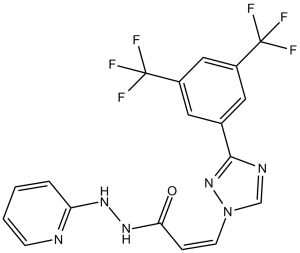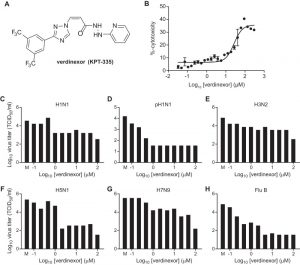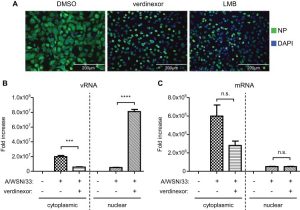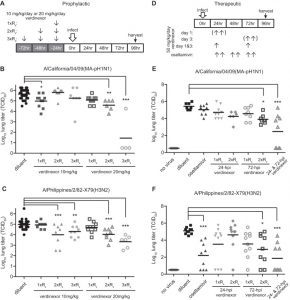This product is for research use only, not for human use. We do not sell to patients.

| Size | Price |
|---|---|
| 250mg | Get quote |
| 500mg | Get quote |
| 1g | Get quote |
Cat #: V1684 CAS #: 1392136-43-4 Purity ≥ 98%
Description: This product has been discontinued. Verdinexor (formerly KPT-335; KPT 335; KPT335) is an orally bioavailable, selective XPO1/CRM1 (Exportin 1/Chromosomal Maintenance 1) inhibitor with potential antineoplastic activity. Verdinexor inhibited proliferation, blocked colony formation, and induced apoptosis of treated cells at biologically relevant concentrations of drug. Additionally, Verdinexor downregulated XPO1 protein while inducing a concomitant increase in XPO1 messenger RNA. Verdinexor treatment of cell lines upregulated the expression of both protein and mRNA for the tumor suppressor proteins p53 and p21, and promoted their nuclear localization.
Publications Citing InvivoChem Products
Product Promise

- Physicochemical and Storage Information
- Protocol
- Related Biological Data
- Stock Solution Preparation
- Quality Control Documentation
| Molecular Weight (MW) | 442.32 |
|---|---|
| Molecular Formula | C18H12F6N6O |
| CAS No. | 1392136-43-4 |
| Storage | -20℃ for 3 years in powder form |
| -80℃ for 2 years in solvent | |
| Solubility In Vitro | DMSO: 88 mg/mL (199.0 mM) |
| Water: <1 mg/mL | |
| Ethanol: 11 mg/mL (24.86 mM) | |
| Solubility In Vivo | N/A |
| Synonyms | KPT-335; KPT335; KPT 335 |
| Protocol | In Vitro | In vitro activity: Verdinexor inhibits the viability of Jurkat, OCI-Ly3, OCI-Ly10, and CLBL1 cells with IC50 of 0.3 nM, 2.1 nM, 41.8 nM, and 8.5 nM, respectively. KPT-335 also induces apoptosis in CLBL1 cells and primary canine DLBCL cells that express XPO1 and SINE. Verdinexor potently and selectively inhibits vRNP export and effectively inhibits the replication of various influenza virus A and B strains, including pandemic H1N1 virus, highly pathogenic H5N1 avian influenza virus, and the recently emerged H7N9 strain. Cell Assay: Cell viability for lymphoid lines is determined by the MTS assay using CellTiter 96® AQueous One Solution Cell Proliferation Assay Kit. Briefly, for lymphoid cell lines, 5×104 cells (or 1×105 primary DLBCL cells) are cultured in 100 µL of complete medium in 96-well plates in the presence of SINE compounds. After 72 hours, 20 µL of MTS solution is added to each well and cells are incubated for another 4 hours before measuring absorbance at 490 nm using a Wallac Victor 1420 Multilabel Counter. The IC50 of SINE is calculated using Prism 6 software. For the non-lymphoid cell lines, 96 well plates are seeded in triplicate in 90 µL with 2500 cells/well of OSA16, 5000 cells/well of C2, and 2500 cells/well of 323610-3. Seeded plates are cultured overnight then treated the following day with 10 µL of KPT-214 in C10 media at concentrations of 0.0001, 0.01, 0.1, 1.0, and 10 µM. Plates are collected at 92 hours, centrifuged at 1300 rpm, and supernatant is removed by inverting plates on absorbent paper. Plates are then sealed and immediately placed at −80°C for a minimum of 12 hours. Plates are then thawed and CyQUANT ®Cell Proliferation Assay is performed following the manufacturer’s protocol. Briefly, 200 µL of the diluted working CyQUANT solution is added to each well and protected from light. Fluorescence is the measured using a SpectraMax M2 microplate reader at 480 nm excitation and 520 nm emission. Results are represented as percent of control, or plotted to calculate IC50 values at 92 hours. |
|---|---|---|
| In Vivo | Verdinexor (KPT-335) is potent in inhibiting virus shedding, moderating leukocyte infiltration into the bronchoalveolar space, and reducing pulmonary pro-inflammatory cytokine expression in mice. | |
| Animal model | BALB/c female mice (6-8 week-old) |
| Solvent volume to be added | Mass (the weight of a compound) | |||
|---|---|---|---|---|
| Mother liquor concentration | 1mg | 5mg | 10mg | 20mg |
| 1mM | 2.2608 mL | 11.3040 mL | 22.6081 mL | 45.2161 mL |
| 5mM | 0.4522 mL | 2.2608 mL | 4.5216 mL | 9.0432 mL |
| 10mM | 0.2261 mL | 1.1304 mL | 2.2608 mL | 4.5216 mL |
| 20mM | 0.1130 mL | 0.5652 mL | 1.1304 mL | 2.2608 mL |
| Quality Control Documentation |
|
|---|
This equation is commonly abbreviated as: C1 V1 = C2 V2
- (1) Please be sure that the solution is clear before the addition of next solvent. Dissolution methods like vortex, ultrasound or warming and heat may be used to aid dissolving.
- (2) Be sure to add the solvent(s) in order.







































